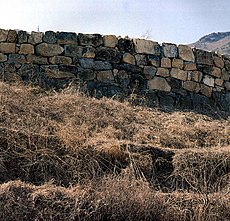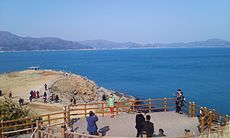Geoje
Geoje
거제시 | |
|---|---|
| Korean transcription(s) | |
| • Hangul | 거제시 |
| • Hanja | 巨濟市 |
| • Revised Romanization | Geoje-si |
| • McCune-Reischauer | Kŏje-shi |
| Nickname: Blue City Goeje | |
 Location in South Korea | |
| Country | |
| Region | Yeongnam |
| Administrative divisions | 9 myeon, 10 dong |
| Government | |
| • Mayor | Min Ho Gwon 권민호 |
| Area | |
| • Total | 402.3 km2 (155.3 sq mi) |
| Population (2013.12) | |
| • Total | 243,736 |
| • Density | 547/km2 (1,420/sq mi) |
| • Dialect | Gyeongsang |
| Website | Geoje City Website |
Geoje is a city located in South Gyeongsang province, just off the coast of the port city of Busan, South Korea. Daewoo Shipbuilding & Marine Engineering (former Daewoo Shipyard) in Okpo and Samsung Heavy Industries (SHI) in Gohyeon are both located on Geoje Island. The city also offers a wide range of tourist sights. The city is made up of a number of islands, of which by far the largest is Geoje Island. There are multiple dong in the city: Jangpyeongdong, Okpo-dong and Gohyeon.
Etymology
Geoje (from Korean Geoje 'Great Crossing';from Geo (Korean)거,(Hanja)巨 'great,large' and je(jae) (Korean)제,(Hanja)濟 'crossing,ferry')
History
In 757, Gyeongdeok of Silla classified the island as "Geoje-gun" "거제군" (Geoje county). Modern Geoje is classified as a "si" (시) (city). In 1170, Uijong of Goryeo secretly escaped to Geoje when Jung Jungbu raised a rebellion against him, instating his brother, Myeongjong as king. Geoje served as a strategic location in preparation of the naval forces for the Gihae Eastern Expedition (기해동정) of Tsushima Island in 1419 by the Korean general Yi Jong Mu. At the time of the Seven-Year War in 1592, admiral Yi Sun-sin gained a great naval victory against Japanese invaders near the town of Okpo in Geoje. Since then. Yi was referred to by his noble title, "Chung Mu Gong," which roughly translates into English as "Earner of Great National Respect."
In the Korean War (1950–53), the military government of General Douglas MacArthur used the island as a place for the settlement for 170,000 POWs, and a prison war camp measuring at 11.8 square kilometres (4.6 sq mi) was established during these years. After the war, a portion (23,000 m2) was converted into a tourist attraction.[1]
The Geneva Convention of 1949 failed to foresee to the development of hardcore, organized prisoner groups on Geoje-do in 1951-52 or to provide protection for the captor nation in dealing with stubborn resistance, mainly as a result of the harsh treatment that the prisoners received from the military government.
Demographics
According to the whitebook published by Geoje City in May 2014, Geoje had a population of 243,736, 12,240 of which are foreigners (non-Koreans). A significant portion of the population depends on shipbuilding to support their livehood, and this can be evidenced by the fact that nearly 33% of workers are employed in the shipbuilding industry.
Tourism
Geoje offers a variety of attractions, including Haegeumgang island, Oedo, a marine western-style botanical garden in Hallyeo-Haesang National Park, built by Lee Chang-ho and his wife when they settled on the island in 1969. Visitors visit by ferry boat from the harbor neighboring the islands.
Tourists also visit Jisim-do for trekking. Jisim is known for its Camellia vegetation. However, the Maemi typhoon in 2003 severely affected the island's plant life. Another popular tourist attraction at Haegeumgang-do (located southeast of Geoje) is the Sipja Donggul Cave. Buddhist and Shamanist sculptures can be found in the cave.
Geoje POW Camp
Geoje POW Camp (거제도포로수용소) was a prisoner of war detention camp for captured North Koreans established during the Korean war from (1951).
Gohyeon Castle

Gohyeon Castle is named the 46th national treasure of South Gyeongsang Province. Gohyeon Castle (고현성) and is located in Gohyeondong, Geoje city. It was established during the Joseon dynasty in 1451.
In the famous Joseon era geography book, Donggukyeojiseungram (동국여지승람), it was recorded that the Gohyeon castle had a circumference of 3,038 Cheok (척) (equivalent to about 9.2km), and had a height of 13 Cheok (3.93m). It was considered the largest castle in the South Sea.[2]
Geoje Township Government Office

The Geoje Township Government Office is regarded as Korea's 84th cultural treasure. During the time of the Japanese invasions, the office was established in 1470 to administer all military and shipbuilding plans.
Okpo Great Victory Park
Okpo Great Victory Park is located in Okpo2Dong within Geoje city. It commemorates the great victory over the invading Japanese navy by the honored general Lee Sunshin on May 7, 1592.[3]
Blue Horse (Poet) Museum
The Blue Horse (Cheongma, 청마) is a cultural exhibition and preserved birthplace museum of the celebrated poet "Blue Horse". It is located in Bangha village, Dundeokmyeon.
Hill of Wind

The Hill of Wind (바람의 언덕) is located in Galgot village, Nambumyeon.(거제시 남부면 갈곶리) It overlooks South Sea and there is strong wind. And an windmill is established on top of hill. It becomes famous after 2 Days & 1 Night, one of the most popular Korea TV show, has been filmed.
Museums

Haegeumgang Themepark Museum
Haegeumgang Themepark Museum (해금강테마박물관) is a museum of travel during the 1950s to the 1970s. It is located in Galgot village, Nambumyeon (거제시 남부면 갈곶리).
Geoje Shipbuilding Marine Cultural Center
The Geoje Shipbuilding Marine Cultural Center is an independently established combination of a Fishing Village Folk Museum and Shipbuilding Theme park museum located in Jisepo village, Ilunmyeon (지세포리, 일운면).
The Fishing Village Folk Museum covers two floors, including 4 exhibits: "The living sea/Traditions of the sea" and "Ocean experience/Renaissance of the sea".
Shipbuilding Theme park museum also covers two floors, including 5 exhibits: "Children's Shipbuilding yard/Dock 1" The history of sailing vessels/Dock 2 Shipbuilding technology/Dock 3 The future of the oceans/ Movie theatre
Geoje Museum
Haegumgang

Haegeumgang is named for resemblance of the famous Haegeum mountain in North Korea. It is one of the most famous tourist destinations in all of Geoje.[4]
Oedo and Naedo

Oedo and Naedo are two islands located in the southeast of Geoje island and of the two, Oedo hosts the second most visited attraction in all of Geoje, the expansive botanical gardens of Botania.
Beaches
|
|
Shipbuilding

There are various Shipbuilding docks which provide tours from the Daewoo and Samsung corporation located in both Gohyeon and Okpo.[5]
Administrative Divisions
According to a 2014 study, Geoje's Korean population was 243,736, and the foreign national population was 12,240.[6] Although Gohyeondong is the fifth smallest of the dongs, it is the largest in population at 40,400. The cumulative area of Geoje is 402.3㎢, with Dongbumyeon (동부면) being the widest, and Majeondong (마전동) being the narrowest.
In 2008 Shinhyeoneup 신현읍 was abolished, and in its place a new town is being installed.
The industrial area of Geoje has the highest man to women worker ratio in Gyeongsangnamdo.
| Town·Township·Dong | Hanja | Area(㎢) | Population[7] | Map |
|---|---|---|---|---|
| Geojemyeon 거제면 | 巨濟面 | 37.30 | 7,114 | |
| Nambumyeon 남부면 | 南部面 | 31.87 | 1,945 | |
| Dongbumyeon 동부면 | 東部面 | 52.50 | 3,682 | |
| Dundeokmyeon 둔덕면 | 屯德面 | 33.78 | 3,693 | |
| Sadeungmyeon 사등면 | 沙等面 | 34.69 | 9,578 | |
| Yeonchomyeon 연초면 | 延草面 | 40.14 | 10,038 | |
| Ilunmyeon 일운면 | 一運面 | 30.50 | 7,468 | |
| Jangmokmyeon 장목면 | 長木面 | 36.89 | 5,410 | |
| Hacheongmyeon 하청면 | 河淸面 | 29.10 | 5,148 | |
| Gohyeondong 고현동 (Geoje city proper) | 古縣洞 | 5.14 | 40,400 | |
| Sangmundong 상문동 | 上門洞 | 20.97 | 21,783 | |
| Suyangdong 수양동 | 水良洞 | 11.15 | 14,433 | |
| Jangpyeongdong 장평동 (Geoje City proper) | 長坪洞 | 6.98 | 29,867 | |
| Neungpodong 능포동 | 菱浦洞 | 3.21 | 12,816 | |
| Majeondong 마전동 (Geoje City proper) | 麻田洞 | 1.92 | 5,673 | |
| Ajudong 아주동 | 鵝州洞 | 12.45 | 13,557 | |
| Okpo1dong 옥포1동 | 玉浦1洞 | 2.26 | 10,560 | |
| Okpo2dong 옥포2동 | 玉浦2洞 | 8.61 | 30,250 | |
| Jangseungpodong 장승포동 | 長承浦洞 | 2.15 | 4,409 |
Geography
Geoje city covers an area of 401.63 square kilometres (155.07 sq mi), encompassing Geoje-do (383.44 square kilometres (148.05 sq mi)) and 60 other small islets, of which 10 are inhabited.[8] The main island is joined to land by two bridges from nearby Tongyeong.
Climate
Geoje experiences a temperate climate, and temperatures reaching below zero degrees Celsius in winter are frequent during December to February. However, the island is kept relatively warm by the influence of warm ocean currents.
| Climate data for Geoje (1981–2010) | |||||||||||||
|---|---|---|---|---|---|---|---|---|---|---|---|---|---|
| Month | Jan | Feb | Mar | Apr | May | Jun | Jul | Aug | Sep | Oct | Nov | Dec | Year |
| Mean daily maximum °C (°F) | 7.3 (45.1) |
9.4 (48.9) |
13.2 (55.8) |
18.3 (64.9) |
22.6 (72.7) |
25.5 (77.9) |
27.6 (81.7) |
29.4 (84.9) |
26.4 (79.5) |
21.9 (71.4) |
15.4 (59.7) |
9.7 (49.5) |
18.9 (66.0) |
| Daily mean °C (°F) | 2.5 (36.5) |
4.3 (39.7) |
8.2 (46.8) |
13.2 (55.8) |
17.5 (63.5) |
21.0 (69.8) |
24.3 (75.7) |
25.6 (78.1) |
21.9 (71.4) |
16.6 (61.9) |
10.3 (50.5) |
4.7 (40.5) |
14.2 (57.6) |
| Mean daily minimum °C (°F) | −1.6 (29.1) |
−0.4 (31.3) |
3.2 (37.8) |
8.1 (46.6) |
12.7 (54.9) |
17.0 (62.6) |
21.6 (70.9) |
22.4 (72.3) |
18.1 (64.6) |
12.0 (53.6) |
5.6 (42.1) |
0.3 (32.5) |
9.9 (49.8) |
| Average precipitation mm (inches) | 41.0 (1.61) |
59.9 (2.36) |
113.8 (4.48) |
177.0 (6.97) |
235.1 (9.26) |
269.9 (10.63) |
426.4 (16.79) |
335.6 (13.21) |
200.7 (7.90) |
63.6 (2.50) |
54.7 (2.15) |
29.7 (1.17) |
2,007.3 (79.03) |
| Average precipitation days (≥ 0.1 mm) | 4.7 | 5.3 | 7.5 | 9.5 | 9.1 | 11.1 | 14.8 | 11.5 | 9.2 | 4.9 | 5.4 | 3.8 | 96.8 |
| Average relative humidity (%) | 53.6 | 53.4 | 56.5 | 59.0 | 65.2 | 71.7 | 78.1 | 74.6 | 70.9 | 65.2 | 61.2 | 55.4 | 63.7 |
| Mean monthly sunshine hours | 163.2 | 178.6 | 201.3 | 216.8 | 232.2 | 187.2 | 147.3 | 183.1 | 172.5 | 206.2 | 165.9 | 167.9 | 2,204.9 |
| Source: Korea Meteorological Administration[9] | |||||||||||||
Islands of Geoje city
Sister cities
 South Jeolla Province Gurye County
South Jeolla Province Gurye County South Gyeongsang Province Hadong County
South Gyeongsang Province Hadong County Longjing, China
Longjing, China Longjing, Jilin
Longjing, Jilin Qinhuangdao
Qinhuangdao Qidong, Jiangsu
Qidong, Jiangsu Guam
Guam Yame, Fukuoka
Yame, Fukuoka
See also
References
- ^ http://www.visitkorea.or.kr/eng/info_db/dest/sight_detail.jsp?seqno=4066
- ^ 《고현성 안내표지판》. 거제시시설관리공단. 2009년 1월 31일에 확인.
- ^ http://www.geojeimc.or.kr/sub.html?w=body_03_02&style=03
- ^ 거제시 관광안내자료, 2009년 1월
- ^ http://www.kmobile.co.kr/k_mnews/news/news_view.asp?tableid=IT&idx=225896
- ^ 2014년 05월말 인구 및 세대(외국인 포함)
- ^ 2011년 6월 31일 기준 인구
- ^ http://i.b5z.net/i/u/1628001/i/Map_low_1.jpg
- ^ "평년값자료(1981–2010) 거제(294)". Korea Meteorological Administration. Retrieved 2011-05-02.


